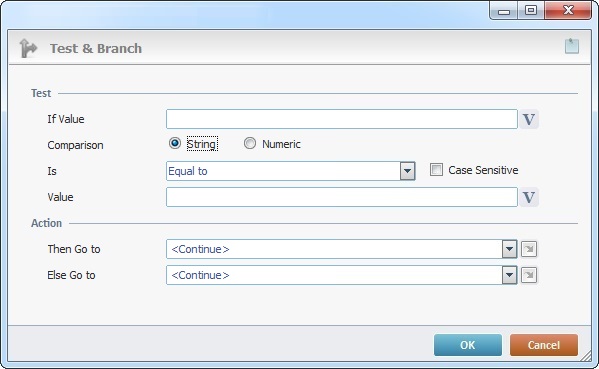Working with Test & Branch Process
Process Purpose
The "Test & Branch" process has two functions. It is used to test specific criteria with the help of an IF Condition and, then, according to the results of this logic test, to redirect the workflow of the application.
Consequently, it requires the specification of two target points in the code (labels, routines, screens, etc).
When you add a process, you are required to define its settings. This occurs in the process's properties window which is displayed automatically after having added the "Test & Branch" process.
If any subsequent edition is required, double-click the process to open its properties window and enter the necessary modifications.

Fill in the options available:
Test |
|||||||
If Value |
Define the first value to compare by entering it OR click |
||||||
Comparison |
Define the type of comparison values by checking "String" or "Numeric". Checking the "String" option enables the "Case Sensitive" option. |
||||||
Is |
Define the comparison criteria by selecting an option from the drop-down.
Note that checking the "Case Sensitive" option forces a lower/upper case comparison. |
||||||
Value |
Define the second value to compare by entering it OR click This option is NOT available, if the selected comparison value is "Empty" (a string comparison possibility). |
||||||
Action |
|||||||
Then Go to |
Select a destination for a "True" result from the drop-down or the
|
||||||
Else Go to |
Select a destination for a "False" result from the drop-down or the
|
||||||
Detail of a ![]() window:
window:

"S:Menu" is a screen included in the same program as the process.
"R:Routine_1" is a routine included in the same program as the process.
If required, use ![]() (on the upper right corner of the properties window) to attach any relevant notes to this process. Click it and enter your notes in the resulting text box. These notes will be displayed in the corresponding "Actions" tab or "Process" window (in the "Notes" field) and in the "Developer Report".
(on the upper right corner of the properties window) to attach any relevant notes to this process. Click it and enter your notes in the resulting text box. These notes will be displayed in the corresponding "Actions" tab or "Process" window (in the "Notes" field) and in the "Developer Report".
After filling in the required options, click ![]() to conclude or
to conclude or ![]() to abort the operation.
to abort the operation.
The added process is displayed in the corresponding "Actions" tab or "Process" window.
![]() If you want to use a label as a target destination, you can use the "Auto-Label" mechanism. This alternative to the "Set Label" process allows you to create a label in the properties window of a process - specifically, in the fields used to define target destinations (ex: the "If Error..." type fields). See To Automatically Create a Label.
If you want to use a label as a target destination, you can use the "Auto-Label" mechanism. This alternative to the "Set Label" process allows you to create a label in the properties window of a process - specifically, in the fields used to define target destinations (ex: the "If Error..." type fields). See To Automatically Create a Label.
![]()
Use the right-click in MCL-Designer's input boxes to access some related options as well as the general "Cut", "Copy"; "Paste"; "Search" actions (active/inactive according to the current context).
Ex: If you right-click the "Variable" input box (included in a "Conversion's" properties window), you are provided with general editing/search actions and other more specific options such as "Variable Select" (see "Variable Select"); "Variable Insert" (see "Variable Insert"); "Insert Special Character" (see To Insert Special Characters into a Control's Text Input Field) and "Localization Select" (see Localization List).
If you right-click another input box, it may provide other possibilities.
